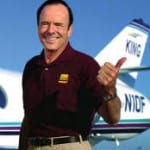“We kill too many people in general aviation.” With that, John King opened an Oshkosh press conference in which he told a room packed with reporters, and officials at Cessna, Avemco Insurance Co., and other companies, that if it was up to him, he’d ban the word safety when talking about aviation.
“Everyone says that safety is the #1 priority, but if that’s true, how do you ever start the engine of an airplane?” he said. “There is always a tradeoff between utility and risk. The key is managing the risk. If you want 100% safety, stay on the ground.”
 He noted that the GA fatality rate hasn’t changed much in the last 10 years. “And we’ve been working hard on it,” he said. “If we just do a better job of what we’ve been doing, it won’t make a difference.”
He noted that the GA fatality rate hasn’t changed much in the last 10 years. “And we’ve been working hard on it,” he said. “If we just do a better job of what we’ve been doing, it won’t make a difference.”
That’s why he’s excited about the new Redbird Skyport, a research and development laboratory that Redbird Flight Simulations plans to open in November at San Marcos Airport (HYI) in Texas.
“It will explore the edges of the envelope,” he said. “Now we are teaching people to preflight things that don’t really matter, like checking an aileron hinge, because that’s the way we’ve been doing it for years. Accidents are caused by things that are going on between the ears of the pilot.”
By incorporating simulators and scenario-based training, the flight industry can produce good pilots who have the essentials skills down the first time they try them in an airplane, Martha King added. “They can learn these skills in a low-risk environment. This give them the opportunity to be a true PIC — a true risk manager.”
Another advantage to incorporating sims is that it will boost retention — a huge problem in GA, as up to 80% of people drop out of flight training.
One reason is the unpredicability of training. Weather, mechanical issues, or scheduling conflicts with instructors can stall training. Expectations also play a big factor, King said.
“Students are told when they start that it will take 35 hours, but it doesn’t take them long to realize that’s not going to happen,” he said. “Low-balling people on the cost of flying is impractical.”
But incorporating simulators into the training means that every time a student drives out to the airport, there will be a lesson, whether it’s in the sim, a ground lesson, or in the air. That helps the student’s learning curve and provides a predictable revenue stream for flight schools — a win-win situation.
For more information: KingSchools.com

Presently, sim time near me costs more than half what airplane time costs. For primary training, I won’t spend that kind of money, considering the limitations of the simulator, I’d rather spend a little more and get the whole experience in a real aircraft. Now, if sim time was a lot cheaper, say $10 – $20/hr., I might consider it. Now, should I move on to an instrument rating, I can envision doing a lot of sim work before the actual air work. I have to disagree with John King’s comment on the “things that don’t matter”. Those things get preflighted because they have historically caused problems, they have the potential to do so again, and a good mechanical preflight instills confidence in the pilot that he can trust the aircraft with his life. But the biggest benefit of the traditional airplane preflight is that it gives the pilot a few minutes to get into “pilot mode”, stop thinking about life outside the airplane and focus, while I’m preflighting I’m also thinking about the flight, weather, airports, and assessing if both the plane and pilot are good to go.
Hmmm….not sure if time in an expensive simulator replaces what is needed most, good stick-and-rudder skills. Since most accidents occur at low altitude, it seems to me we need to focus more on the basics. Why not consider the syllabus followed in Germany years ago, which started by keeping the wings level on an otherwise stationary, no-cockpit glider. Eventually pilots “advance” to short hops, then to bungee and tow launches. Start with a glider certificate before allowing any motorized flight, and keep radios and instruments to a bare minimum. We don’t allow children to start with a racing bicycle, but with a small tricycle. Can we imagine the same for training people how to fly?
Hmmm….not sure if time in an expensive simulator replaces what is needed most, good stick-and-rudder skills. Since most accidents occur at low altitude, it seems to me we need to focus more on the basics. Why not consider the syllabus followed in Germany years ago, which started by keeping the wings level on an otherwise stationary, no-cockpit glider. Eventually pilots “advance” to short hops, then to bungee and tow launches. Start with a glider certificate before allowing any motorized flight, and keep radios and instruments to a bare minimum. We don’t allow children to start with a racing bicycle, but with a small tricycle. Can we imagine the same for training people how to fly?